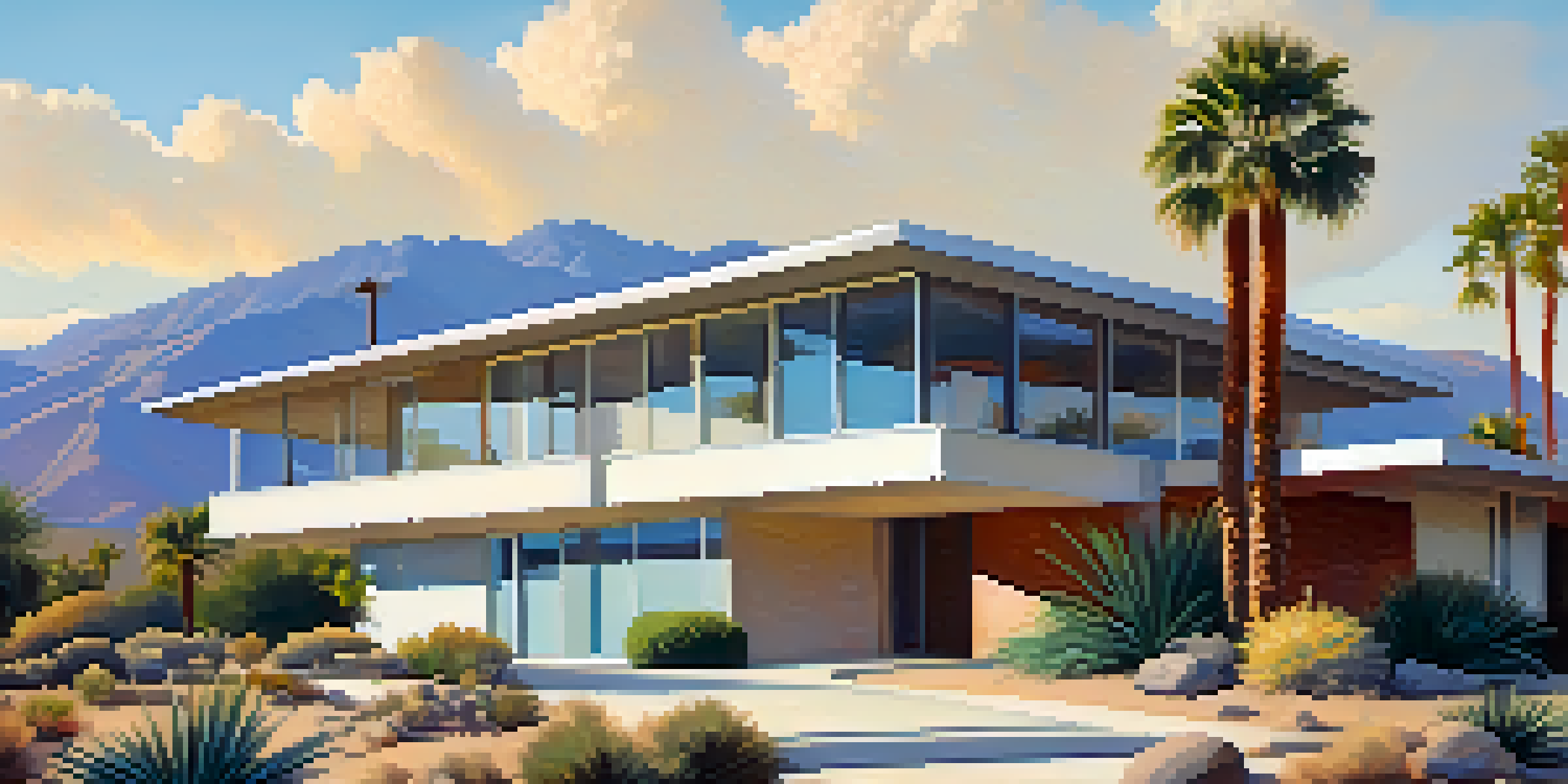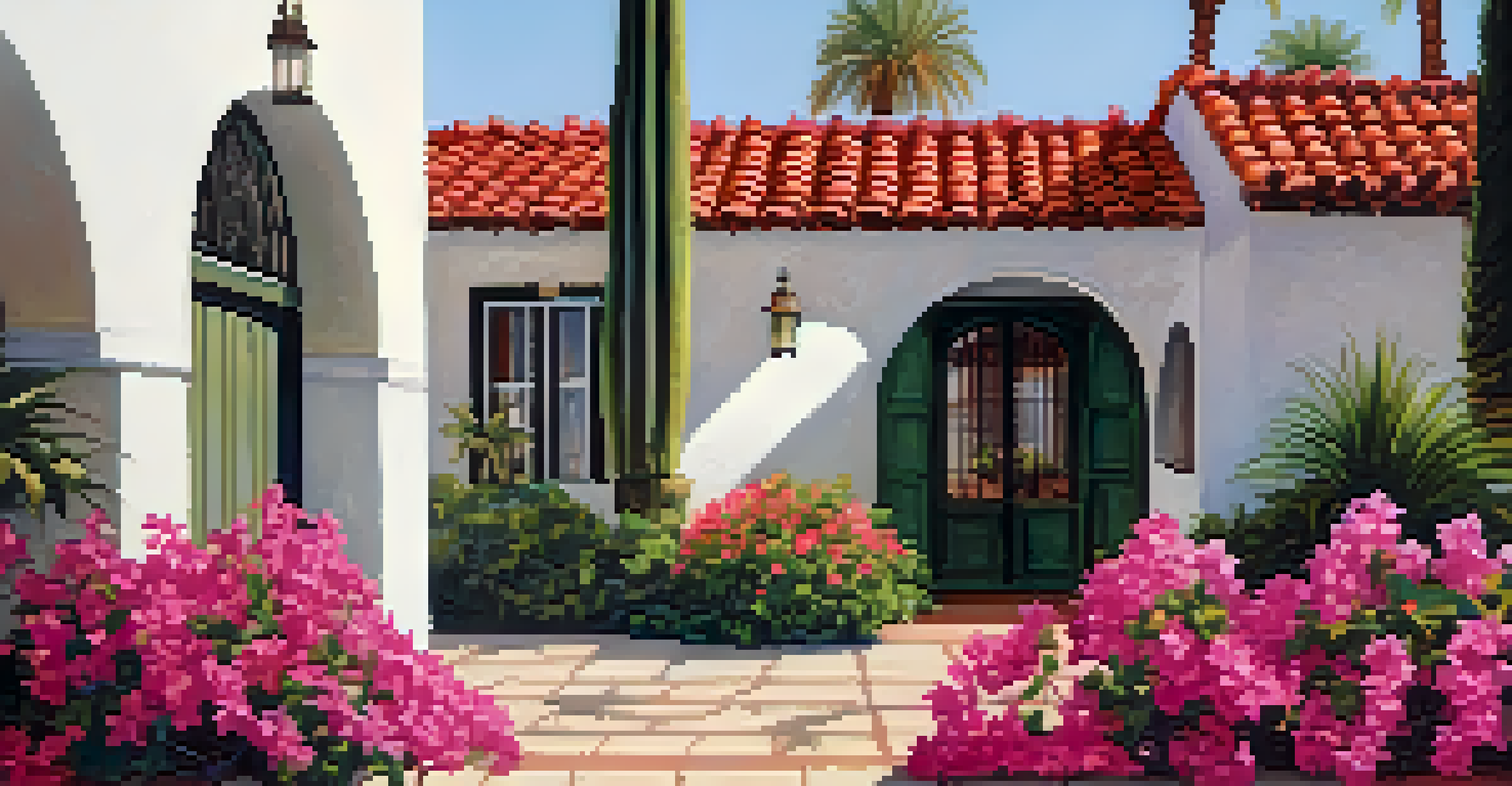The Evolution of Palm Springs Historic Districts: A Timeline

The Birth of Palm Springs: Origins and Early Development
Palm Springs, known today for its glamorous lifestyle and mid-century modern architecture, began as a modest desert oasis. The area's indigenous Cahuilla people first inhabited the land, utilizing its natural resources long before European settlers arrived. In the late 1800s, the region started to attract visitors seeking the therapeutic benefits of its warm climate.
Preservation is a form of empowerment. It allows us to take ownership of our history and shape our future.
The arrival of the Southern Pacific Railroad in 1876 marked a significant turning point, making Palm Springs more accessible to tourists. This increased interest led to the establishment of the first hotels and guest houses, laying the groundwork for its reputation as a resort destination. As more people visited, the community began to grow, and the foundations of its historic districts were laid.
By the early 20th century, Palm Springs was on the map, with more homesteaders and developers arriving. Their vision for a vibrant desert community directly influenced the architectural styles that would come to define the area. This period set the stage for the evolution of Palm Springs into a beloved retreat for Hollywood's elite and everyday travelers alike.
The Rise of Mid-Century Modernism in the 1940s-1960s
The mid-20th century ushered in a design revolution in Palm Springs, with mid-century modernism capturing the imagination of architects and residents alike. This distinctive style, characterized by clean lines, open spaces, and a seamless connection to nature, became a defining feature of the city. Notable architects like Richard Neutra and Albert Frey played pivotal roles in this architectural renaissance.

As Palm Springs became a playground for the rich and famous, many iconic homes were built during this period, reflecting the laid-back lifestyle of Southern California. These residences often featured large windows and outdoor living spaces, inviting the stunning desert landscape inside. This design ethos not only catered to aesthetics but also to the region’s climate, maximizing cooling and natural light.
Palm Springs' Historic Origins
The evolution of Palm Springs from a modest desert oasis to a renowned resort destination was shaped by its natural resources and early tourism.
The influence of mid-century modernism is still palpable today, with many neighborhoods preserving their authentic character. The city has embraced this architectural heritage, with tours and events celebrating the style. As a result, Palm Springs has become a mecca for design enthusiasts and tourists eager to experience its unique charm.
The Creation of Historic Districts: A Community Effort
In the 1990s, residents and preservationists began to recognize the importance of protecting Palm Springs' architectural legacy. This collective effort led to the establishment of several historic districts, aimed at safeguarding the unique architectural styles and historical significance of the area. The city’s commitment to preservation soon became a point of pride for its residents.
Architecture should speak of its time and place, but yearn for timelessness.
Each historic district showcases different architectural styles, from Spanish Revival to the iconic mid-century modern homes. The designated areas serve as living museums, educating visitors about the city’s rich history while allowing residents to maintain their homes. This initiative has helped to foster a sense of community and appreciation for the city’s heritage.
As a result of these efforts, Palm Springs was designated a Certified Local Government, recognizing its commitment to historic preservation. This status not only facilitates funding and resources for preservation projects but also engages the community in the ongoing dialogue about maintaining the city’s unique character. Palm Springs’ historic districts have become a symbol of resilience and dedication to the past.
Challenges in Preservation: Balancing Growth and Heritage
As the popularity of Palm Springs surged, so did the challenges of preserving its historic districts. Developers and investors saw the potential for profit, which sometimes clashed with the community's desire to maintain its architectural integrity. This tension has sparked debates about the future of the city and how to balance growth with preservation.
The city has implemented regulations and guidelines to protect historic properties, ensuring that any new development is in harmony with the existing character. However, the struggle between modernization and preservation continues, with advocates fighting to keep the spirit of Palm Springs alive. This ongoing dialogue is essential for maintaining the city's identity in the face of rapid change.
Mid-Century Modernism's Impact
The mid-20th century brought a design revolution to Palm Springs, establishing mid-century modernism as a defining architectural style.
Residents have taken an active role in these discussions, often advocating for their neighborhoods and participating in city planning meetings. By engaging in these conversations, they help ensure that Palm Springs remains a vibrant community that honors its past while looking towards the future. The balance between preserving history and accommodating growth is a delicate dance that continues to evolve.
Cultural Significance: Palm Springs as a Design Destination
Over the years, Palm Springs has transformed into a cultural hub, attracting artists, designers, and architects from around the world. The city hosts events like Modernism Week, celebrating mid-century architecture and design, which draws thousands of visitors each year. This cultural significance has cemented Palm Springs' status as a premier destination for design enthusiasts.
The vibrant arts scene complements the city’s architectural charm, with galleries, installations, and performances enriching the community. This convergence of art and architecture has fostered a unique atmosphere that continues to inspire creativity. The city’s commitment to preserving its historic districts plays a crucial role in this cultural renaissance, attracting those who appreciate both history and artistry.
As Palm Springs evolves, it remains dedicated to nurturing this creative spirit, ensuring that both locals and visitors can experience its rich heritage. The interplay between design, culture, and history is a testament to the city’s enduring appeal. This dynamic environment encourages ongoing exploration and appreciation of Palm Springs’ unique legacy.
Looking Ahead: The Future of Palm Springs Historic Districts
As we look to the future, the preservation of Palm Springs' historic districts remains a vital topic for residents and city officials alike. With increasing interest in sustainable development, the city faces the challenge of adapting to modern needs while preserving its unique character. This forward-thinking approach is essential for ensuring that Palm Springs thrives for generations to come.
Community engagement will continue to play a crucial role in shaping the future of these districts. By involving residents in the planning process, the city can ensure that new developments align with the values and aesthetics that define Palm Springs. This collaborative effort fosters a sense of ownership and pride among residents, helping protect their architectural heritage.
Preservation Amidst Growth Challenges
Balancing the preservation of historic districts with modern development remains a critical focus for Palm Springs' community and city officials.
Ultimately, the future of Palm Springs' historic districts lies in striking a balance between preservation and progress. By valuing its history while embracing innovation, Palm Springs can continue to be a vibrant and beloved destination. The journey ahead promises to be as captivating as the city’s past, rich with opportunities for growth and appreciation.
Conclusion: Celebrating the Legacy of Palm Springs
In conclusion, the evolution of Palm Springs' historic districts reflects a rich tapestry of cultural, architectural, and community values. From its humble beginnings to its status as a design destination, the city's journey is a testament to the power of preservation. Each district tells a unique story, contributing to the vibrant identity of Palm Springs.
As we celebrate the legacy of this remarkable city, it's essential to recognize the ongoing efforts of residents, preservationists, and city officials. Their commitment to maintaining the charm and character of Palm Springs ensures that future generations can enjoy its beauty and history. This shared responsibility fosters a sense of community and pride that is palpable throughout the city.

Ultimately, Palm Springs stands as a shining example of how a community can honor its past while embracing the future. By continuing to cherish and protect its historic districts, Palm Springs will remain a beloved oasis in the desert, captivating the hearts of all who visit.